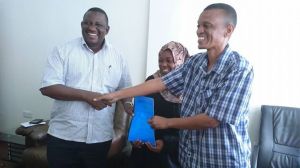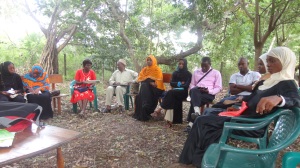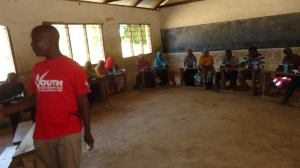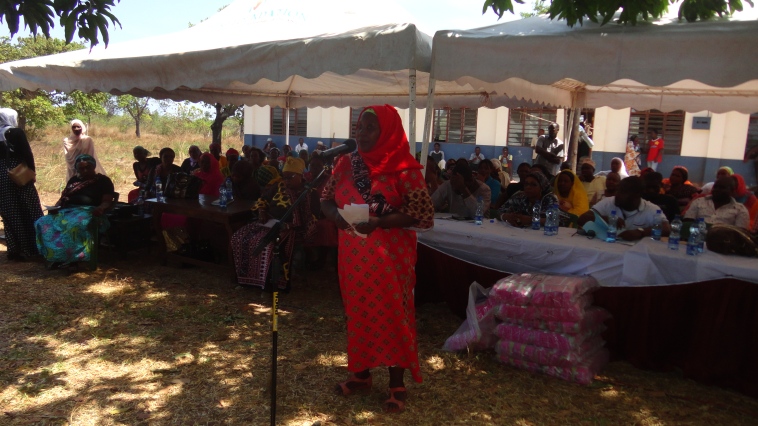Author: Sauti Ya Wakwale
Msambweni Focus Group Discussion
Lunga Lunga Women training
Are women their own enemies?
Msambweni Sub-county Maendeleo ya Wanawake Chairperson, Zeituni Bakari Semayote addressing participants during the International Women’s Day at Nyumba Mbovu in Kinondo Ward, Msambweni Sub-county
Disunity in the women leadership in Kwale played out today during celebrations to mark the world International Women’s. Day. While the event is meant to bring women together, in Kwale two factions of Maendeleo ya Wanawake Organization held separate meetings. One group led by Ms Zeituni Bakari held its meeting at Nyumba Mbovu in Kinondo Ward at a ceremony which was attended by the area Member of Parliament Suleiman Dori and a host of Members of County Assembly led by the host Juma Maone. Another group which is believed to be enjoying the support of Kwale County Women Representative Zainab Chidzuga held its meeting in Kwale town-a move Msambweni MP Suleiman Dori termed as divisive.
The women organization’s apparent crack contradicted this year’s theme “Make it Happen”- a slogan which was seen by many as a way of steering women leadership to greater heights.
Division among womenfolk in Kenya and Kwale in particular has been cited as the major reason women have failed to win elective positions over the years. Out of the twenty electoral wards in Kwale County, there is no single elected woman. Apart from Ms Chidzuga, the only other woman who has been elected to parliament was Ms Marere wa Mwachai nearly two decades ago. The ten women in the county assembly are beneficiaries of the affirmative action courtesy of the new constitution.
Kwale CSOs to form an umbrella body
Civil society organizations working in Kwale County will soon have a central secretariat if the talks among leaders of various local organizations bear fruit. The objective of establishing an umbrella body for the local community based organizations and groups has been made necessary by the presence of so many organizations whose mandate is not clear. The proliferation of groups doing community work has resulted in duplication of projects and activities whose impact is hardly felt on the ground.
In September last year, the local CSOs operating mainly in Msambweni, Matuga and Kinango held a meeting in which it was resolved that the civil society should strengthen networks and have common positions on issues affecting the community. Subsequently, an idea of coming up with Kwale County Civil Society Working Group (KCCSWG) was floated. Though largely a loose out, the group has been instrumental in bringing various organization working in Kwale to adopt a common position on a number of governance issues of interest to the Kwale people. Among the issues that the group has made its presence felt in include the Mining Bill 2014, the Kwale County Bursary Bill which has since been enacted into law. Recently, the group was among participants in the poorly attended meeting to discuss the public participation bill at Red Cross hall in Ukunda.
The group representatives led by Kwale Human Rights Network Coordinator George Jaramba, poked holes in the bill which they informed the County Assembly’s Committee on Justice and Delegated Legislation that needed more input from the public before it is taken for debate in the assembly. The group also presented views to the task-force on historical injustices which sat in Mombasa late last year.
But the group now seeks to formalize itself and play a more vital role of establishing strong networks and work towards influencing policy direction at the county government departments. If it finally formalizes, the group’s likely pioneer members will be Kwale Human Rights Network (Kwale Hurinet), Kwale County Natural Resources Network (KCNRN), Kwale County Education Network (KCEN) and Muslims for Human Rights (MUHURI) which operates in all the six coastal counties.
Others include Lamukani CBO and Msambweni Human Rights Watch (Msamwatch) both of which are affiliate members of Kwale Hurinet. The three networks are currently partnering with Aga Khan Foundation-Kenya in Kwale to implement a project dubbed Citizen Voices in Governance. The project focuses on promotion of gender equality, education and livelihoods through sustainable development. The three networks are working closely with the relevant departments at the county government to implement the project aimed at enhancing equal opportunities for gender participation in governance as well as address the dwindling education standard in Kwale. The livelihood component which is undertaken by KCNRN is crucial in uplifting the lives of the local populace in the face of the increase of extractive industry in the sub-region.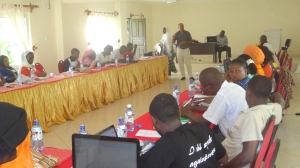
Aga Khan Foundation-Kenya Coast Regional Manger Atrash Mohamed addressing a capacity building workshop at Hillpark Hotel in Kwale
Kwale CIDP attracts more interest after launch
Kwale County Integrated Development Plan (CIDP) is arguably one of the most ambitious development blueprints in Kenya. While presiding over the official launch of the document, UNDP Resident Representative in Kenya Nardos Bekele Thomas, commended Kwale government for coming up with a pro-citizen document.
But even as the document gains attention among development pundits, the question that is being raised is whether there is room for its amendment to accommodate emerging issues. In a forum held at Kenyan School of Government in Matuga on February 11, 2015, local civil society leaders raised concerns that there are emerging issues which need to be incorporated in the CIDP.
“Does the CIDP have a specific approach to address the rampant drug trade in Kwale County?” asked Cosmus Maina of Teenswatch Centre, a community based organization that addresses drug abuse among the youth. But the Chief Officer for Community Development Sylvia Chidodo informed the meeting that the county government was already working closely with the National Authority for the Campaign Against Alcohol and Drug Abuse (NACADA) to address the drug menace. She however informed the meeting that the county government has no mandate of arresting or prosecuting drug barons as that responsibility lies with the national government.
Mahmoud Barroh of Msambweni Human Rights Watch challenged the county government to mentor women leaders to be able to participate effectively in the elective political process. But Ms Chidodo explained that the CIDP had a component for women economic empowerment. “As civil servants, however, it’s not within our mandate to empower people politically,” said the Chief Officer.
An official of Asili Natural Resources Consortium Elsheber Oketch asked what has been done to bring on board the persons with disabilities or any support the county government had offered the few local schools for people with disabilities. The county government, said Ms Chidodo, only plays a supporting role but the National Council of People with Disability have a mandate to address the welfare of PWDs.
One participant informed the meeting that boda boda (motor bike taxi) riders have made 14 girls pregnant in Kinango and that Vinyunduni Dispensary constructed more than ten years ago is yet to become operational. Nyanje Chirongo Tsuma wondered what the county government was doing to address the challenges in Kinango including the limited mobile phone network which has impeded communication in the area.
Other issues raised in the meeting included the prominent presence of gays and lesbians in Kwale and how the county government intended to enhance the gender equality. Kwale Human Rights Network Coordinator George Jaramba noted that there is need to incorporate emerging issues in the CIDP. Ms Chidodo agreed with Jaramba the document could be amended to accommodate the concerns that may not have been captured in the original document. She however clarified that CIDP was a legal document and could only be amended through a legal process.
Ms
Report of the exchange visit to Baragoi, Samburu County 23rd to 29th March, 2014.
Objective of the visit:
The main objective of the visit/experience learning and mentorship programme was to facilitate members of the networks/forums to visit and engage in discussions with other county networks/forums on development, growth and operations of natural resource based networks/forums. Participants exchange ideas, share and learn lessons that could be useful in the growth and work of individual networks/forums. Learning by seeing is one of the best ways of developing CSOs capacities.
This exchange visit comprised representatives from Kwale, Nakuru & Laikipia County Natural Resource Forums/Network to visit Samburu County Natural Resource Forum (SACONARF).
KCNRN PROGRESS OVERVIEW
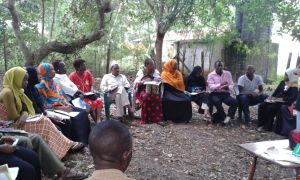 By 2016, KCNRN focuses in increasing participation of Kwale County CSOs in Natural Resources governance, policy processes and implementation towards appreciation of their values both locally and internationally.
By 2016, KCNRN focuses in increasing participation of Kwale County CSOs in Natural Resources governance, policy processes and implementation towards appreciation of their values both locally and internationally.
What specific objectives is the project intended to achieve
1. To build the capacity of the local community in understanding the rules, policies on natural resource management and their existing opportunities.
2. To Strengthen the capacity and functioning of the Kwale County Natural Resources Network
3. To create alternative Media engagement as a sources of publicity and innovatively developing a database for resources funding within the County.
For the year 2013/2014 KCNRN has made a significant improvement in terms of bringing CSOs in Kwale County to form a formidable platform that addresses issues of Natural Resources Management, Advocacy and Networking with other players.
The stated goals and objectives of Strengthening CSOs and Community Participation in Natural Resources Governance in Kwale County project relate to those in the EAWLS and ILEG plans.
During the period, the following three objectives were addressed;
1) By October 2014 the Capacity of the local community was built in understanding the rules, policies on natural resource management and their existing opportunities.
By October 2014 Strengthening the capacity and functioning of the Kwale County Natural Resources Network was implemented,
3) By October 2014 Collectively developed and Compiled a database for community based organization in Kwale County working to address Natural Resources.
Progress made so far
a. Capacity of the local community has been built in understanding the rules, policies on natural resource management and their existing opportunities:
The Kwale County Natural Resources Network (KCNRN) continued to influence NRM decisions and related issues in Kwale County, Coast region and nationally. Through recognition as voice representing NRM issues at the County as witnessed by the number of high level meeting they were invited to attend. These included consultation meetings with the County Governor, County Cabinet Secretary of Lands, Mining and Natural Resources, County Cabinet Secretary in Community Development, Sports and Children as a result the Governor and Cabinet Secretaries planned a support strategy to facilitate KCNRN to move around the County to continue creating advocacy to wider communities of Kwale, County Coordinator of National Drought Management Authority, County Coordinator of Kenya Agricultural Productivity Agribusiness Project. We had a constructive meeting with Private sector Base Titanium ltd and Lafarge Ecosystem where the Network made partnership and increased resource base and opportunities,
We had a meeting with Diani Chale Marine Park and BMU stakeholders and discussed ways to mitigate challenges, understanding policies of Marine park and opportunities existence in marine ecosystem where we involved Fisheries officer from Shimoni Station.
On proposed mining of Niobium and Rare Earth minerals in Kaya Mrima forest, NEMA declined to issue a mining license as most of the issues raised by the CSOs in Kwale had not been addressed. The KCNRN successfully brought together communities living adjacent to Shimba Hills ecosystem, ILEG, KFS and KWS to openly discuss issues of Human Wildlife Conflicts, Poaching and other illegal activities in Shimba Hills. As a result, the communities together with KFS and KWS develop actions point that both would adhere to ensure they work together. As a result of training on EIA process conducted to members of KCNRN, the network has established a technical team that will be reviewing and providing inputs on all EIA study reports for proposed development projects in environmentally sensitive areas to this we reviewed an ESIA report done by Cortec M ltd on the proposed processing plant and submitted our concerns to NEMA before the deadline o 10/7/2013 only to hear NEMA has issued a recommendation letter to Cortec Company allowing them to construct the processing plant.
Towards enhancing the capacity of KCNRN members to be able to effectively manage and report its activities and expenditures we had two trainings one on financial management skills, filling of returns and governance and another one on Training in reporting compliance to legal requirements and information management
b. To strengthening the capacity and functioning of the Kwale County Natural Resources Network is being implemented,
Increased community participation in Group Dynamics and Management, benefit negotiating skills which was aimed towards enhancing the capacity of KCNRN members to be able to effectively manage and report its activities and expenditures we had two trainings one on financial management skills, filling of returns and governance and another one on Training in reporting compliance to legal requirements and information management as a result of this there are proper documented reports, Minutes, surrender and data of members who register to the Network. Also the Network executive and Secretariat were empowered with management and financial reporting skills.
During the period, in popularizing the Network, we held Constituency level meetings in lunga lunga, Msambweni, Kinango and Matuga where we met Msambweni Beekeepers Association, members of SEGA Charcoal Producer Association and Local farmers. Also we had a meeting in Taru Kinango Sub County where we met with Nuru CBO a local community based organization which has 400 members and create d awareness and understanding KCNRN Objectives and status.
During this period, several meetings on Environment and Natural Resources Management were attended. The Network members attended a 5 days training on Environmental Impact Assessment understanding legal terms and processes organized by WWF. The Network Secretariat together with a member of the Network attended two weeks training on policy and advocacy analysis at MSTCDC in Arush on policy issues. These trainings are part of WWF agenda to develop capacity of partners on advocacy. Other meetings and training workshops attended that relate to County NRM Network agenda during the quarter included, East African Wildlife Society (EAWLS) lessons sharing and learning event in Nairobi where we shared our findings, progress and challenges and made contacts with other networks, attended Kenya Coast Forest Conservation Forum to validate their constitution and attend their Annual General Meeting held in Mombasa Reef hotel and participated in its Election of its officials.
We participated in a Governors Round Table meeting where we discussed proposals to be adopted by the County Government when developing its policies and regulations in the field of Natural resources.
As For membership drive, efforts were seen where we conducted an intensive outreach and managed to recruited 34 individual new members and one Kaya Lukunda Conservation Organization which has 18 members, Majimboni Environmental and Natural resources Organization which has 30 members, Nuru CBO which has 400 members, Mwakamba Development group which has 21 members and Base Titanium ltd which currently has 1500 workers joined the Network, raising the total membership to 1973.We all know that advocacy is numbers.
Presence of a natural resources platform in Kwale County has been welcomed by a wider section of Community, Private Sector and Government Agencies whom are now working together to compliment efforts that will add value to the livelihoods, Natural Resources and economic investment.
c. To create alternative Media engagement as a sources of publicity and innovatively developing a database for resources funding within the County.
This objective has not been implemented so far due to inadequate funding but for database we managed to compile and have the current groups operating in Kwale County in relation to Natural Resources and Environmental Conservation.
We also managed to consult An IT expert for the development of the Network WEB SITE in which is yet to be launched and you can link to http:www.kcnrn.org for more information.
Planned Activities:
1. Follow Up Activity for the Commitments made by Governor of Kwale during the Courtesy Visit where the following areas were discussed and they needed feedback
Establishment of information centers/ service centers (public access to information) – in which we has agreed this action needs the development of a Policy and actual service centers.
Kwale County Natural Resources Network to be involved in the Development Planning meetings both at Sub County and County level with reference to the office of the Governor therefore an action is to make a follow up visit and make further engagement.
As promised by the Governor they will explore available opportunities to facilitate operations of Network to carry out more advocacy on Natural Resources Management, Functions of County Government and increase public participation.
To inquire about the planned Mapping of Natural Resources in the County and possible forward our findings.
We did some Courtesy Introduction to County Executives and other offices; Namely
Done:
a) County Executive in charge of Land and Mining,
b) County Executive in charge of Youth & Women and County Development (MTP I & II),
c) Co-coordinator of National Drought Management Authority,
d) County Geologist,
e) County Service Unit of Kenya Agricultural Productivity Agribusiness,
f) KWS Senior Warden and Community Warden,
g) Private Sector;- Base Titanium ltd, and LAFARGE-Bamburi Cement ltd and
h) Ramisi Secondary
School (consumption of water
problem);
-where we are required to advise both the School Administration, County Education Officer, Water Coordinator, County Government, Students and their parents on water resource safety and purification.
i) Involvement of the Network in Integrated Strategic Planning –
As County Government are in their final preparation to come up with their Integrated Strategic Plan therefore as a Network we should make a bold move and inquire if at all it captured our submissions,
j) We held an Organizational Capacity Assessment that brought a lot of gaps and recommendations as a way forward to adopt.
k) We managed to develop a 5 year strategic plan and launched it at a functioned blessed by 4 Kwale County Executive Committee members.
l) We are also developing Network policies that will effectively govern our institution e.g. Election Policy, Monitoring and Evaluation Policy, Advocacy Strategy, Human Resources Policy, Communication Strategy and Financial Policy
m) We have managed to forward our comments on Natural Resources Benefit sharing bill 2014, Water Bill, Climate Change Bill and Policy and now we are spear heading the development of County Forest Bill.
n) We managed to conduct various survey on biological issues please find the reports attached.
ISSUES AFFECTING DEVELOPMENT OF NATURAL RESOURCES IN KWALE COUNTY
Kwale County is one among the Counties that is rich in natural resources, however there are issues significant in Kwale County that either direct or indirect affect the development of its natural resources. these issues include:
• Emergence of large-scale mining that could impact negatively on other natural resources
• Human- wild life conflicts especially around Shimba Hills National Reserve and Samburu/Mackinnon areas of Kinango
• Increased extraction of wood fuel for various industries and institutions
• Limited capacity and lack of awareness among the community groups on the responsibilities and opportunities available to them in natural resource management.
• Lack of tangible benefits sharing mechanisms for revenues generated though Natural Resources exploitation.
The above issues are critical to Kwale County because these touch on the livelihoods, security, and health of the community as well as the immediate fate of the natural resource base. A disconnect between the community and the natural resource base is detrimental both to the community and to the resources. A re-connect is the only solution that will ensure sustainability in resource utilization as well as continued development among the community members. Previously, sectarian efforts were engaged in solving these problems. Different community groups and government institutions focused only on the specific areas of interest. Consequently, this has resulted in fragmented achievements that do not add up to whole.
To overcome these challenges, a concerted effort is proposed, that includes the political will to act, a sensitized and cooperative community, and a responsive county government. The current proposed project, therefore, intends to seize the opportunity created by the new constitution dispensation which allows for devolution of National resources management issues to County government, as well as the requirement of community participation in the decision making process in all levels of government.
MINING IN KWALE COUNTY, WHERE IS THE COMMUNITY?
KCNRN POLICY BRIEF
Policy Brief No 1, 2014
MINING IN KWALE COUNTY, WHERE IS THE COMMUNITY?
This Policy Brief targets Kwale County Government, Senators, Members of the National Assembly, Members of Kwale County Assembly, the National Environment Management Authority (NEMA), the Kenya Forest Service (KFS), the Kenya Wildlife Service (KFS), Mining Companies, International and local communities, among other stakeholders concerned with advocacy for best practices in the Extractive Industry.
Executive summary.
Kenya is headed to a robust mining industry, and it is only prudent that this starts off in the right footing. Existing policies related to mining need to be formulated to favour the community and governments; and policies under review, or those to be formulated (especially at County level) need also to consider value addition to benefits, and safety. The existing policies need to define royalty and it must be pegged on the mineral value rather than the traditional basis of company profit value. The Government needs to take up an oversight role to ascertain records and material quantity and type involved in the mining. Some functions such as monitoring and oversight need to be devolved, so as to ensure efficiency and complementarity between the National and County governments. Additional funds such as Development Fund and Heritage Fund need to be introduced in the Mining Bill to broaden the local benefits from the resource. New mineral discoveries in ongoing mining activities need to be subjected to a new Environmental Impact Assessment (EIA), and if the mining involves a radioactive element, a health survey
should be mandatory. Proponents need to be specific on the mineral extracted, avoiding terminologies such as ‘rare earths’ which stands for diverse elements of different value and effects.
Background
Kwale County is among the exceptionally well endowed Counties with riches in Natural Resources (NR) arising from its landscape diversity, these include: land, forests, water, wildlife, pasture, and minerals. As far as large scale mining is concerned, generally Kenya and Kwale County specifically, are inexperienced hence the need to start on the right footing. Livelihoods, safety, post mining impacts and mitigation, and effective monitoring and evaluation; specifically occupation health and safety, need to be thoroughly thought through visa vis the economic gains (taxes, levies and royalties) related to the minerals. With regard to economic benefits, the percentage gains as royalties and the distribution of these royalties among beneficiaries also need to be
reviewed. World over, it is common that mining activities do not reflect the development of an area. This can be interpreted to mean, the wealth distribution is not in favor of the local community in mining areas. Moreover, royalties have always been defined based on company profit and not the mineral value and this could be attributed to governments and communities’ lack of guidelines and expertise to ascertain the factual accounts related to such losses. There are cases where miners discover new minerals other than what was captured in the original EIA report, and mining licenses/agreements but do not disclose. In some cases, the new discoveries involve radioactive elements, which are hazardous to human lives. For example, in the Kenyan South Coast, Mrima Hill has a discovery that comprise of radioactive minerals (EIA report 2011, volume 5 page. 15), and mining could start soon. Similar cases are potential for neighboring Kiruku and Nguluku Hills. In other cases, proponents may lump individual minerals together and refer to them using one name, for example, rare earths that may include specic metals with different values and effects.BriefThe word “royalties” is not dened in the Mining and Minerals Bill 2011. The Natural Resources (County Royalties) Bill, 2013, denes royalties as ‘non-tax revenue in the form of compensation for the use of natural resources, expressed as a percentage of receipts from using the natural resources or as a payment for each unit produced’. In this context the use of the word “receipts” makes the definition vague. The need for an explicit definition of royalties for easy interpretation is therefore, paramount.
Problem Statement
1. ROYALTIES (Taxes, Levies, Charges and
Corporate Social Responsibility (CSR)
PROBLEM STATEMENT
The Chamber of Mines guidelines dene royalties as ‘a percentage payment from the prot in the mining products trade’; this is irrespective of the mineral value. Guidelines to companies on payment of royalties are not elaborate in the Mining Bill. The distribution is better explained in the Natural Resources (County Royalties) Bill, 2013 as: 75%, 20% and 5% for National Government, County Government and Community respectively.
However, since the County government and the community will bear the highest brunt of the impacts of the mining activities; therefore, their royalty shares needs to be raised.
In other countries, mining policy reviews are bringing in additional but relevant funds e.g. Development Fund, Security Bonds, and Heritage Funds. In Kenya, Environmental Management and Coordination Act (EMCA),1999 and the Mining Bill highlight the Security Bond for mitigation, but leaves the valuing of the Bond at the discretion of the sitting Minister (Cabinet Secretary). A better valuing system is needed here.
KCNRN’S STATEMENT OF INTEREST
Kcnrn Statement Of Interest In The Issue
Kwale County Natural Resource Network (KCNRN) is an advocacy group focusing on Natural Resource Management (NRM), aiming at sensitizing and mobilizing communities to play an active role in NRM, and in formulation and /or review of policies related to NRM, at both the County and National levels. Network membership is diverse hence a wealth of knowledge, expertise and experiences in NRM. For public interest, the Network collaborates with relevant stakeholders to ensure that Natural Resources (NR) are exploited sustainably and equitably. The Network also promotes information sharing between stakeholders on NRM issues.
KCNRN ADVOCACY ACTION IN THE MINNING BILL
1. KCNRN has participated in some of the meetings where these policies were discussed. These include a meeting with a Senate Committee that deliberated on royalty distribution ratios between National Government, County Government and Community as entrenched in the Mining and Minerals Bill 2011 and the Natural Resource (County Royalties) Bill 2013. The Network has been active in EIA reviews and submissions, as well as EIA public barazas (consultations).
2. They reviewed the Cortec Niobium Processing Plant at Kiruku project Environmental and Strategic Impact Assessment (ESIA) report, compiled comprehensive and documented comments which were later shared among stakeholders and submitted to National Environment and Management Authority (NEMA).
3. KCNRN representatives visited the Kwale Governor Hon Salim Mvurya and discussed issues of ecosystem destruction, community compensation and protection of citizen as a result of mining activities anticipated at Mrima Hill Forest. As a result, the County Executive Member for Lands, Mining, Environment and Natural Resources pledged to support the Network. Additionally, this office assured the network that they are not supporting the issuance of mining licenses and approvals without a d d r e s s i n g h ow t h e C o u n t y Government of Kwale will benefit, how the Radioactive elements will be disposed and how the community will benefit.
4. The Executive Committee of the network submitted a letter to NEMA and the Kwale County Government as an appeal not to offer licenses to mining companies. As a result, the Cabinet Secretary for Mining cancelled licenses for 43 companies including Cortec K Limited.
5. The network has partnered with local FM Radio stations to share, inform
and advocate the public on Mining benefits, Challenges, Community participation and Benefit sharing, Conservation of Ecosystem and policy enforcement.
6. The network has written positional papers on mining activities in Kwale mainly to highlight key hotspots, c o m m u n i t y c o n c e r n s a n d conservation measures,
2.| KCNRN POLICY BRIEF | Policy Brief No 1, 2014
RECOMMENDATIONS.
1. All policies and legislation related to mining must define royalties explicitly for the public, mining companies and policy implementers to have the same understanding.
2. The royalties’ definition need to be based on the mineral value rather than on the company profit. Poor trading strategies cannot be an excuse to deny a nation benefits of her mineral resource.
3. There is need for clear guidelines to legalize governments or state departments to be directly involved in the monitoring of mining activities, including operations, financial reports and documentation. This would help in ensuring checks and balances for both trade and environmental aspects, as per the agreed terms and conditions or the policies and agreements.
4. The Mining Bill needs to consider the introduction of a Development fund and a Heritage fund, in addition to the Security Bonds that exists in the Mining Bill. There needs to be an instruction for any new discovery, the proponent has to do a new EIA that puts the new mineral into consideration; and new negotiations and licensing process
started.
5. Proponents should specify the extracted mineral based on the Government geologist’s definitions which must be precise to the metal or stone. Generalized and obscure terminologies such as Rare earths need not be used in agreements and licenses.
6. The Mining Bill must include as a prerequisite a Health Survey for a mining activity that involves radioactive minerals; followed by subsequent health monitoring for the surrounding community and mining employees.
7. In the Natural Resources (County Royalties) Bill, 2013, the Community Natural Resources committee needs to be reviewed and membership must include affected communities , Community-Based Organizations (CBOs), Civil Society Organizations (CSOs), marginalized and professional groups for full community participation in decision making in mining.
8. Devolution of some mining functions, especially day to day overseeing of
mining activities at County level. There is need for County Governments to be supported and their capacity built towards developing legislation that strengthens National policies in mining.
